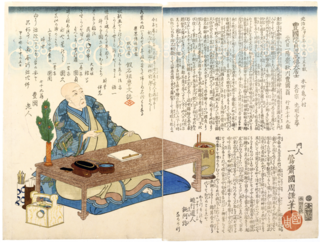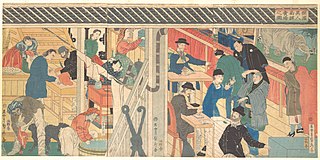
Utagawa Kuniyoshi was one of the last great masters of the Japanese ukiyo-e style of woodblock prints and painting. He was a member of the Utagawa school.

Konishi Hirosada was the most prolific Osaka-based designer of ukiyo-e woodblock prints during the late Edo period. Like most producers of kamigata-e (上方絵)—prints originating in the Osaka and Kyoto regions—he specialized in yakusha-e actor prints. Hirosada is particularly known for his diptychs and triptychs, and for his many ōkubi-e portraits of the leading actors on the Osaka kabuki stage during his day.

Utagawa Yoshiiku, also known as or Ochiai Yoshiiku, was a Japanese artist of the Utagawa school.

Hiroshige II was a Japanese designer of ukiyo-e art. He inherited the name Hiroshige II following the death in 1858 of his master Hiroshige, whose daughter he married. In 1865 he moved from Edo to Yokohama after dissolving his marriage and began using the name Kisai Risshō. His work so resembles that of his master that scholars have often confused them.

Utagawa Toyokuni II (1777–1835), also known as Toyoshige, was a designer of ukiyo-e Japanese woodblock prints in Edo. He was the pupil, son-in-law and adopted son of Toyokuni I. The former used the name Toyoshige (豊重) until 1826, the year after his teacher's death, when the family gave him the right to use his teacher's name and he began signing his work Toyokuni (豊国). In 1835 he died, and in 1844 the family persuaded Kunisada, the most famous student of Toyokuni I, to use the name "Toyokuni" and become leader of the school. Although Kunisada never recognised Toyoshige's right to the name Toyokuni, nevertheless Kunisada after 1844 is always referred to as Toyokuni III.
Ukiyo-e artists may be organized into schools, which consist of a founding artist and those artists who were taught by or strongly influenced by him. Artists of the Osaka school are united both stylistically and geographically. Not all of these artists designed woodblock prints, and some ukiyo-e artists had more than one teacher, and others are not known to be associated with any particular school.

The term aizuri-e usually refers to Japanese woodblock prints that are printed entirely or predominantly in blue. When a second color is used, it is usually red. Even if only a single type of blue ink was used, variations in lightness and darkness (value) could be achieved by superimposing multiple printings of parts of the design or by the application of a gradation of ink to the wooden printing block (bokashi).
Utagawa Hirokage, also known as Ichiyūsai Hirokage, was a Japanese designer of ukiyo-e woodblock prints, who was active from about 1855 to 1865. He was a pupil of Utagawa Hiroshige I. From 1860 to 1861, Hirokage designed the series of ōban size prints titled Edo meisho dōke zukushi. His reputation is based primarily upon this series and his 1859 triptych Aomono sakana gunzei daikassen no zu.

Utagawa Kunimasu was a designer of ukiyo-e woodblock prints in Osaka who was active during the late Edo period. He was a leading producer of kamigata-e, prints from the Osaka and Kyoto areas. He is also known as Sadamasu [貞升], the artist name he used prior to Kunimasu.

Utagawa Yoshitora was a designer of ukiyo-e Japanese woodblock prints and an illustrator of books and newspapers who was active from about 1850 to about 1880. He was born in Edo, but neither his date of birth nor date of death is known. However, he was the oldest pupil of Utagawa Kuniyoshi who excelled in prints of warriors, kabuki actors, beautiful women, and foreigners (Yokohama-e). He may not have seen any of the foreign scenes he depicted.

Utagawa Yoshitsuya, also known as Kōko Yoshitsuya (甲胡 芳艶) and as Ichieisai Yoshitsuya (一英斎 芳艶), was a Japanese designer of ukiyo-e woodblock prints.

Urakusai Nagahide, was a designer of ukiyo-e style Japanese woodblock prints who was active from about 1804 to about 1848. He is also known as Yūrakusai Nagahide (有楽斎 長秀), Nakamura Nagahide, Chōshū (長秀), and as Chōshūsai (長秀斎). “Nagahide” and “Chōshū” are written with the same kanji. The ending “sai” means studio or hall, and is added or omitted at will by many Japanese artists.

Shunbaisai Hokuei, also known as Shunkō III, was a designer of ukiyo-e style Japanese woodblock prints in Osaka, and was active from about 1824 to 1837. He was a student of Shunkōsai Hokushū. Hokuei’s prints most often portray the kabuki actor Arashi Rikan II.

Shunkōsai Hokushū (春好斎 北洲), who is also known as Shunkō IV, was a designer of ukiyo-e style Japanese woodblock prints in Osaka who was active from about 1802 to 1832. He is known to have been a student of Shōkōsai Hambei, and may have also studied with Hokusai. He used the name Shunkō (春好) until 1818, when he changed his name to Shunkōsai Hokushū. He was the most important artist in Osaka during the 1810s and 1820s and established the Osaka style of actor prints.

Shini-e, also called "death pictures" or "death portraits", are Japanese woodblock prints, particularly those done in the ukiyo-e style popular through the Edo period (1603–1867) and into the beginnings of the 20th century.

Uchiwa-e (団扇絵) are a genre of Japanese ukiyo-e woodblock print, which appear on rigid, paddle-shaped hand fans known as uchiwa (団扇). Ovoid images matching the outline of uchiwa were printed on rectangular sheets of washi rice paper, then cut along the margins and pasted onto a skeletal bamboo frame.

Ryūsai Shigeharu (柳窗重春/柳斎重春) (1802–1853) was an Osaka-based Japanese ukiyo-e woodblock print artist active during the first half of the nineteenth century. A member of the Utagawa school, he was one of a very select group of kamigata-e print artists who were able to support themselves solely as professional artists.

Utagawa Sadahide, also known as Gountei Sadahide, was a Japanese artist best known for his prints in the ukiyo-e style as a member of the Utagawa school. His prints covered a wide variety of genres; amongst his best known are his Yokohama-e pictures of foreigners in Yokohama in the 1860s, a period when he was a best-selling artist. He was a member of the Tokugawa shogunate's delegation to the International Exposition of 1867 in Paris.
Kaika-e is a genre of Japanese woodblock prints (ukiyo-e) during the Meiji period that celebrated the Westernization of Tokyo and its people.
Sketches of the Life of the Great Priest is a series of ten Japanese woodblock prints in ink and color on paper made by ukiyo-e artist Utagawa Kuniyoshi (1798–1861). It was published by Iseya Rihei in 1835–1836. The prints, which are in the large, horizontal, multi-colored woodblock format, tell the story of Nichiren (1222–1282), a Japanese Buddhist priest, philosopher and founder of Nichiren Buddhism. The series is referred to by many names, the result of various English translations, with Illustrated Abridged Biography of the Founder one of the more popular titles.






![[Jin Xi Wei Jian Sheng Wu Meng Hu Zhi Zhen Tu ] -Never Seen Before- True Picture of a Live Wild Tiger (Konjaku miken, Ikimono moko no shinzu) MET DP148115.jpg](http://upload.wikimedia.org/wikipedia/commons/thumb/0/0a/%E3%80%8C%E4%BB%8A%E6%98%94%E6%9C%AA%E8%A6%8B_%E7%94%9F%E7%89%A9%E7%8C%9B%E8%99%8E%E4%B9%8B%E7%9C%9F%E5%9B%B3%E3%80%8D-Never_Seen_Before-_True_Picture_of_a_Live_Wild_Tiger_%28Konjaku_miken%2C_Ikimono_m%C5%8Dko_no_shinzu%29_MET_DP148115.jpg/263px-%E3%80%8C%E4%BB%8A%E6%98%94%E6%9C%AA%E8%A6%8B_%E7%94%9F%E7%89%A9%E7%8C%9B%E8%99%8E%E4%B9%8B%E7%9C%9F%E5%9B%B3%E3%80%8D-Never_Seen_Before-_True_Picture_of_a_Live_Wild_Tiger_%28Konjaku_miken%2C_Ikimono_m%C5%8Dko_no_shinzu%29_MET_DP148115.jpg)

















